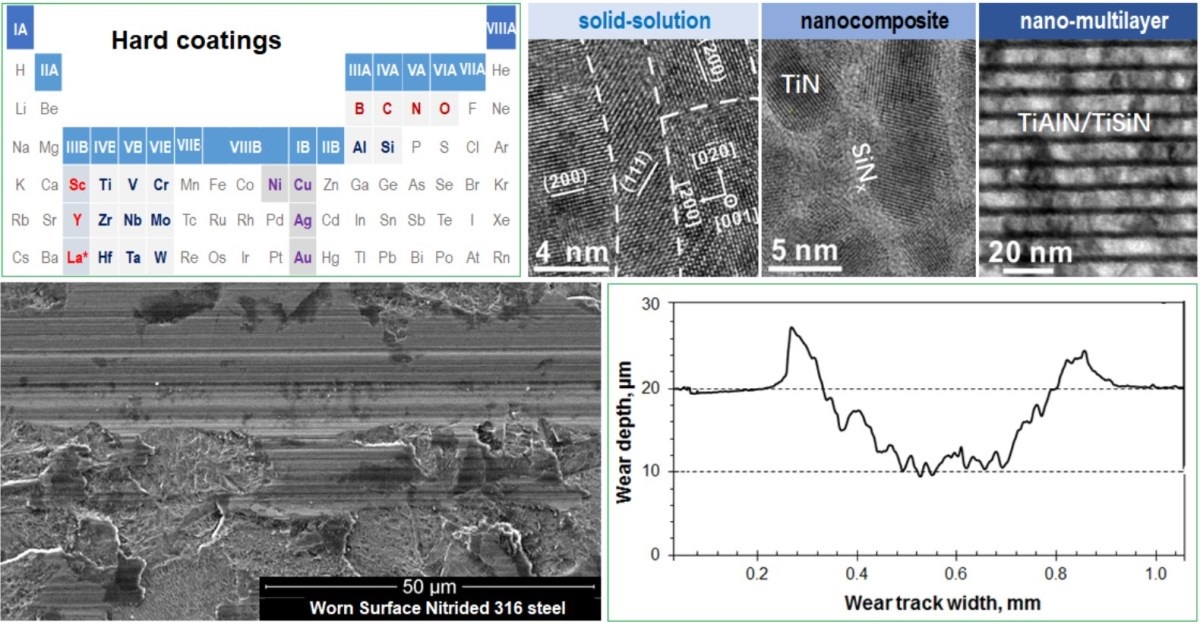Wear and Friction of High-Performance Coatings and Hardened Surfaces
A special issue of Lubricants (ISSN 2075-4442).
Deadline for manuscript submissions: 31 August 2026 | Viewed by 5987

Special Issue Editors
Interests: wear and friction properties; wear mechanisms; transmission electron microscopy; residual stress measurement; PVD hard coatings; solid lubricant coatings; plasma nitriding; wear resistant steels; failure investigation
Special Issues, Collections and Topics in MDPI journals
Interests: nanocomposite coatings; hybrid PVD techniques; coatings for cutting tools; tribology in metal machining; surface engineering technology; high-temperature protective coatings
Special Issues, Collections and Topics in MDPI journals
Special Issue Information
Dear Colleagues,
Wear is a major engineering material failure, while friction is known to contribute to the severity of wear and reduce the efficiency of machinery. Research and advances in this field have been significant in recent decades. In this Special Issue, we welcome the contribution of original research papers, topic reviews and industrial case studies that reflect the latest scientific and technological advances in wear-resistant coatings and hardened surfaces.
- The coatings are materials developed via physical and chemical vapour deposition, spraying and cladding processes, including, but not limited to, transition metal nitrides and carbides, diamond-like carbon (DLC) and other carbon-based coatings, metallic/ceramic multilayers and composites, multicomponent and high-entropy alloys.
- The hardened surfaces include those engineered via thermal chemical treatments such as nitriding, energetic peening and other surface-hardening processes.
- The wear and friction properties may include those determined by dry and lubricated machining, sliding/rolling, abrasion, erosion and fretting wear.
- Wear and friction mechanism studies include the characterization of worn surfaces and subsurfaces, as well as wear debris, by means of electron microscopy, electron/ion spectroscopy, crystallography, 2D/3D surface topographic analyses, and micro/nano indentation, as well as the measurement of surface residual stresses.
- The industrial case studies include failure investigations related to wear and friction, as well as the industrial application of high-performance coatings and hardened surfaces.
We appreciate your consideration and sincerely hope that you will accept our invitation to contribute to this Special Issue.
We look forward to hearing from you soon.
Dr. Quanshun Luo
Prof. Dr. Qimin Wang
Guest Editors
Manuscript Submission Information
Manuscripts should be submitted online at www.mdpi.com by registering and logging in to this website. Once you are registered, click here to go to the submission form. Manuscripts can be submitted until the deadline. All submissions that pass pre-check are peer-reviewed. Accepted papers will be published continuously in the journal (as soon as accepted) and will be listed together on the special issue website. Research articles, review articles as well as short communications are invited. For planned papers, a title and short abstract (about 250 words) can be sent to the Editorial Office for assessment.
Submitted manuscripts should not have been published previously, nor be under consideration for publication elsewhere (except conference proceedings papers). All manuscripts are thoroughly refereed through a single-blind peer-review process. A guide for authors and other relevant information for submission of manuscripts is available on the Instructions for Authors page. Lubricants is an international peer-reviewed open access monthly journal published by MDPI.
Please visit the Instructions for Authors page before submitting a manuscript. The Article Processing Charge (APC) for publication in this open access journal is 2600 CHF (Swiss Francs). Submitted papers should be well formatted and use good English. Authors may use MDPI's English editing service prior to publication or during author revisions.
Keywords
- wear resistance
- friction
- self-sdaptive lubrication
- hard coatings
- surface engineering
- sliding wear
- wear mechanisms
- residual stresses
- failure investigation
Benefits of Publishing in a Special Issue
- Ease of navigation: Grouping papers by topic helps scholars navigate broad scope journals more efficiently.
- Greater discoverability: Special Issues support the reach and impact of scientific research. Articles in Special Issues are more discoverable and cited more frequently.
- Expansion of research network: Special Issues facilitate connections among authors, fostering scientific collaborations.
- External promotion: Articles in Special Issues are often promoted through the journal's social media, increasing their visibility.
- Reprint: MDPI Books provides the opportunity to republish successful Special Issues in book format, both online and in print.
Further information on MDPI's Special Issue policies can be found here.






